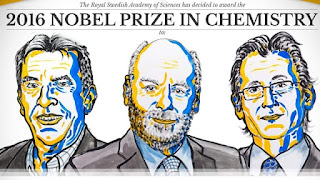 |
| Image Source: DNA India |
Topics: Chemistry, Nobel Laureate, Nobel Prize
October 3: Physiology or Medicine
October 4: Physics
October 5: Chemistry
October 7: Peace
October 10: Economic Sciences
Press Release: The Nobel Prize in Chemistry 2016
5 October 2016
The Royal Swedish Academy of Sciences has decided to award the Nobel Prize in Chemistry 2016 to
Jean-Pierre Sauvage
University of Strasbourg, France
Sir J. Fraser Stoddart
Northwestern University, Evanston, IL, USA
and
Bernard L. Feringa
University of Groningen, the Netherlands
"for the design and synthesis of molecular machines"
They developed the world's smallest machines
A tiny lift, artificial muscles and miniscule motors. The Nobel Prize in Chemistry 2016 is awarded to Jean-Pierre Sauvage, Sir J. Fraser Stoddart and Bernard L. Feringa for their design and production of molecular machines. They have developed molecules with controllable movements, which can perform a task when energy is added.
The development of computing demonstrates how the miniaturisation of technology can lead to a revolution. The 2016 Nobel Laureates in Chemistry have miniaturised machines and taken chemistry to a new dimension.
The first step towards a molecular machine was taken by Jean-Pierre Sauvage in 1983, when he succeeded in linking two ring-shaped molecules together to form a chain, called a catenane. Normally, molecules are joined by strong covalent bonds in which the atoms share electrons, but in the chain they were instead linked by a freer mechanical bond. For a machine to be able to perform a task it must consist of parts that can move relative to each other. The two interlocked rings fulfilled exactly this requirement.
The second step was taken by Fraser Stoddart in 1991, when he developed a rotaxane. He threaded a molecular ring onto a thin molecular axle and demonstrated that the ring was able to move along the axle. Among his developments based on rotaxanes are a molecular lift, a molecular muscle and a molecule-based computer chip.
Bernard Feringa was the first person to develop a molecular motor; in 1999 he got a molecular rotor blade to spin continually in the same direction. Using molecular motors, he has rotated a glass cylinder that is 10,000 times bigger than the motor and also designed a nanocar.
"The 2016 Nobel Prize in Chemistry - Press Release". Nobelprize.org. Nobel Media AB 2014. Web. 5 Oct 2016
< http://www.nobelprize.org/nobel_prizes/chemistry/laureates/2016/press.html >
Comments